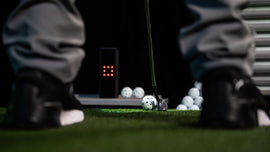Club head speed is how fast your club is moving when it strikes the ball. Simple as that. Get the measurement right, train smart, and you'll unlock serious distance gains.
What is club head speed?
Think of it like this – your club head's doing anywhere from 80mph to 113mph when it hits the ball. That's motorway speeds. The faster it goes, the further your ball flies. Basic physics.
Tour pros average around 113mph with their drivers. Weekend golfers? We're talking 80-95mph. That gap is where the opportunities lie.
Decoding data to improve your club head speed
Your swing mechanics matter. Your timing matters. How fit you are matters too. But without proper data, you're just guessing.
FlightScope technology, Mevo+ measures your club head speed to the decimal point. It lets you track your progress over weeks and months, to see what works versus what feels like it should work.
Here's the thing about Flightscope's launch monitor data – it shows you exactly which bits of your swing generate speed. No more wasted practice sessions. Whether you're in the simulator, on the course, or at the range, you'll know what's working.
Practical guidance for increasing club head speed
Bryson's backswing power moves
Bryson DeChambeau generates serious power through three specific backswing moves that you can copy. Golf Digest's Michael Breed broke down DeChambeau's swing to reveal his secrets.
First, keep that trail arm straight on the takeaway. Bryson extends his right arm longer than any player in professional golf. This forces your body to turn early and fully. Think of your arms and chest forming a triangle at address. Maintain that triangle as long as possible.
Second, hinge your wrists late in the backswing. Bryson's wrists don't start hinging until the club is halfway back. This keeps the grip as far from your body as possible, creating width and power. Golfers who hinge early give up distance.
Third, make a massive chest rotation. Because Bryson keeps his right arm extended, his chest turns 90 degrees in the first half of the backswing. His shoulder turn reaches 110 degrees when fully stretched.
Cameron McCormick's 60-second speed drill
Jordan Spieth's coach has a simple trick to increase swing speed in just one minute. All you need is a Theraband or a long piece of elastic.
Cut the band to five feet. Place it underneath your lead foot, tuck it under the grip, and hold it in both hands. Take practice swings, stretching the elastic as high as possible over your back shoulder. Pull it back like drawing a bow – the distance you take the handle back governs how much speed you can create.
Then set up over a ball immediately after the elastic exercise. Try to stretch the handle up as high as you can to duplicate that sensation. McCormick explains: "increase the distance of that hand path, the length the grip travels back, accelerate through, and hit it further."
Sergio Garcia's lag secret
The king of lag for 25 years has been Sergio Garcia. At just 5-foot-10 and 180 pounds, he's one of the longest drivers in professional golf. His secret lies in the start of the downswing – turning forward while keeping the club back.
Sergio creates a wide swing arc by keeping his right arm extended. This gives him space to drop the club inside on the downswing, with the clubhead staying back – that's lag. He starts the downswing by driving his lower body toward the target, letting his hands and arms simply fall from the top as his body drives forward.
Think sidearm pitching in baseball. Pitchers wind up, shift forward, and rotate toward home plate. The elbow leads the wrist, with the hand trailing. This stores power for maximum velocity when it is released. Golf's the same – shift forward and keep your trailing elbow in front of your trailing wrist for as long as possible.
Distance doesn't lie. And neither does club head speed data from Flightscope. More speed means more distance, and shorter approaches into every green.




